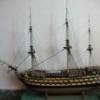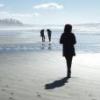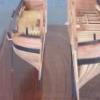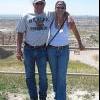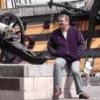-
Posts
4,879 -
Joined
-
Last visited
Reputation Activity
-
 gjdale reacted to Mike Y in Schooner Polotsk 1777 by Mike Y and his daughter - Master Korabel - 1:72
gjdale reacted to Mike Y in Schooner Polotsk 1777 by Mike Y and his daughter - Master Korabel - 1:72
Thanks Karl! Yes, I am also quite surprised with her passion to building stuff, and trying to feed this passion by showing her different techniques, materials, doing it together, encouraging, etc. No matter what career path she will choose, an engineering mindset will never hurt!
This time she also dictated her first post in the build log. I just translated it to english with minimal syntax corrections:
I am building this ship with my dad. He helps me, but I build it myself. I am a Daughter Daria.
We are making a ship body (hull). I am gluing the parts:
This is the center of the ship, I insert the parts here:
And remove an extra glue with a stick:
We used clamps to help the glue stick parts together:
I also made some wooden things with a file. These things are now inside the ship.
Here we glued the deck. It was hard to fit all that parts at the same time!
Our ship will be big! With a long masts and big sails. We will ship some things, food, paintings and curtains on it, as well as toys and doll stuff.
-
 gjdale got a reaction from hamilton in 1949 Chris-Craft 19' Racing Runabout by gjdale - FINISHED -Dumas - 1:8 Scale - RADIO
gjdale got a reaction from hamilton in 1949 Chris-Craft 19' Racing Runabout by gjdale - FINISHED -Dumas - 1:8 Scale - RADIO
Thanks Bob, Keith, Carl and David for the comments (and the pictures David - very cool), and also for all the "likes".
I applied one coat of clear coat this week in preparation for the boot topping and artwork. I used my new mini-spray gun for this and learned a little in the process – primarily that my little airbrush compressor is only just up to the job for this. The spray gun sucks a lot of air (it needs about 30 - 40psi to shoot the clear coat), so short bursts and some patience while the compressor re-charges are required. There is a little bit of an ‘orange peel’ effect evident on this coat, but that will disappear with further coats and light sanding (and improved operator technique).
To apply the boot topping, I used two new products. First up, some pinstriping stencil tape from Finesse. Quite expensive, but does a super job. Essentially it is two pieces of masking tape with a clear carrier tape over the top. It is applied as “one” tape, and then the carrier tape is removed, leaving two perfectly parallel masking lines.
The second product I stumbled across in the LHS while picking up some extra paint. It is a masking tape combined with plastic sheeting. It comes in a roll like this”
As you can see, one edge has standard Tamiya yellow masking tape, which is pre-attached on one edge to some thin plastic sheeting that unfolds to be 550mm (nearly 2 ft) wide. By running the tape along the outer edge of one side of the Finesse stencil, the sheet was wide enough to go completely over the model where it was taped down with some more Tamiya tape to the stencil on the other side. The process was repeated for the opposite side of the stencil and in no time at all the hull was completely masked except for the boot topping space. If anyone is interested, the Tamiya product ID is 87164**640
The boot topping was airbrushed on using Vallejo Model Air White (71.001) at about 15psi. The first coat was left for about two hours (I had to go out) and then a second coat applied. About 30 minutes later I removed the masking and voila!
I’ll leave this to fully cure overnight and then apply another clear coat before starting on the artwork.
-
 gjdale reacted to Mike Y in Beavers Prize 1777 by Mike Y - 1:48 - POF - Hahn style
gjdale reacted to Mike Y in Beavers Prize 1777 by Mike Y - 1:48 - POF - Hahn style
In a meanwhile, tested different ebony dyes on pear. This is a lighter pear, the one that was included into the timbering set from Lumberyard. Should be perfect for the purpose, colour deviation makes no difference if you put a dye on it
Found two dyes available, both from Liberon, one is water-based, another is spirit-based. Water-based works as I expected, but does not penetrate the wood deep enough. The spirit one is very weird, not a uniform structure, looks dirty and does not give a consistent colour. You can't apply multiple coats of it, the instruction says "second coat can tear out the first coat". But penetrates the wood better than the water-based (cut off a few slices to check that). Okay...
On this photo, spirit-based dye is in the bottom, and water-based is on top, near the corresponding can:
Close-up (sorry, on this photo and all other photos - water-based is in the bottom, spirit-based is on top):
Then applied different finishes on them.
Again, water-based dye is in the bottom, spirit-based dye is on top.
Left side - no finish applied at all.
Center - three coats of danish oil
Right side - two coats of tung oil.
Now I will cover half of each section with the paper, and put this test piece into direct sunlight for a while, until it would be a time to install wales. So I probably have a year
The idea is to see how a certain finish will change over time, exposed to UV.
Will follow up!
-
 gjdale reacted to ggrieco in Heroine 1838 by ggrieco - FINISHED - Scale 1:24 - Western River Steamboat as she appeared before hitting a snag in the Red River
gjdale reacted to ggrieco in Heroine 1838 by ggrieco - FINISHED - Scale 1:24 - Western River Steamboat as she appeared before hitting a snag in the Red River
Sorry to be out of touch for the last few weeks. A couple family events, a defensive driving course and a run-in with the norovirus has kept me from posting. I'm still dragging along with the second model as well. This week I did manage to plank most of the boiler deck and half of the hurricane deck. Just for fun I decided to jump ahead to the capstans.
A capstan was not found on the wreck but the hole in the deck for one was found. Heroine's capstan must have been removed some time before wrecking because a small plank was nailed over the hole. Below is Kevin's idea of what her capstan might have looked like.
Whelps fresh off the mill.
Parts of the trundelhead.
I used a boxwood plug to hold the three parts of the trundelhead together for soldering.
Brass parts ready for blackening.
Completed capstan minus the pawls and pawl rims.
Completed cabin stove. Sorry - a little dusty. I never see the dust until after I take the photos.
Boiler deck partially planked. Starting on the Hurricane deck.
Starboard side of Hurricane deck planked. Heroines hurricane deck was covered with tarred canvas. Once planked I with cover the deck with silk and paint it black.
-
 gjdale got a reaction from Canute in 1949 Chris-Craft 19' Racing Runabout by gjdale - FINISHED -Dumas - 1:8 Scale - RADIO
gjdale got a reaction from Canute in 1949 Chris-Craft 19' Racing Runabout by gjdale - FINISHED -Dumas - 1:8 Scale - RADIO
Thanks guys.
Keith - yes, I was aware of the little bit of "orange peel" but am confident I will deal with that with the remaining coats and sanding. Thanks for the links for the micromesh - I've got some really small pieces (about 50mm square) but was starting to think about finding some on a larger scale. I've just ordered a bunch from the linked site, so when the Admiral asks, I'm blaming you okay?
-
 gjdale got a reaction from Canute in 1949 Chris-Craft 19' Racing Runabout by gjdale - FINISHED -Dumas - 1:8 Scale - RADIO
gjdale got a reaction from Canute in 1949 Chris-Craft 19' Racing Runabout by gjdale - FINISHED -Dumas - 1:8 Scale - RADIO
Thanks Hoff - no problem answering questions here - that doesn't count as a "highjack".
It started with fibreglass cloth and 3 coats of West Systems Epoxy Resin (using their 207 Hardener). The "shiny" stuff that goes over that is a Feast Watson Spar Marine Varnish that has been diluted with 10% Mineral Turpentine and sprayed on. At the moment there is only one coat of that in place and it looks almost satin in appearance. By the time I have applied the remaining 4 or 5 coats, it will look a lot shinier. Then the hard work of polishing will begin. I have a cunning plan for that but you'll have to stay tuned to find out what that is........
Incidentally, the main reason for using the Spar Marine varnish is that it contains UV protection. As this boat is going to be exposed to the elements, it makes sense to use products designed for such.
-
 gjdale got a reaction from flying_dutchman2 in 1949 Chris-Craft 19' Racing Runabout by gjdale - FINISHED -Dumas - 1:8 Scale - RADIO
gjdale got a reaction from flying_dutchman2 in 1949 Chris-Craft 19' Racing Runabout by gjdale - FINISHED -Dumas - 1:8 Scale - RADIO
Thanks Bob, Keith, Carl and David for the comments (and the pictures David - very cool), and also for all the "likes".
I applied one coat of clear coat this week in preparation for the boot topping and artwork. I used my new mini-spray gun for this and learned a little in the process – primarily that my little airbrush compressor is only just up to the job for this. The spray gun sucks a lot of air (it needs about 30 - 40psi to shoot the clear coat), so short bursts and some patience while the compressor re-charges are required. There is a little bit of an ‘orange peel’ effect evident on this coat, but that will disappear with further coats and light sanding (and improved operator technique).
To apply the boot topping, I used two new products. First up, some pinstriping stencil tape from Finesse. Quite expensive, but does a super job. Essentially it is two pieces of masking tape with a clear carrier tape over the top. It is applied as “one” tape, and then the carrier tape is removed, leaving two perfectly parallel masking lines.
The second product I stumbled across in the LHS while picking up some extra paint. It is a masking tape combined with plastic sheeting. It comes in a roll like this”
As you can see, one edge has standard Tamiya yellow masking tape, which is pre-attached on one edge to some thin plastic sheeting that unfolds to be 550mm (nearly 2 ft) wide. By running the tape along the outer edge of one side of the Finesse stencil, the sheet was wide enough to go completely over the model where it was taped down with some more Tamiya tape to the stencil on the other side. The process was repeated for the opposite side of the stencil and in no time at all the hull was completely masked except for the boot topping space. If anyone is interested, the Tamiya product ID is 87164**640
The boot topping was airbrushed on using Vallejo Model Air White (71.001) at about 15psi. The first coat was left for about two hours (I had to go out) and then a second coat applied. About 30 minutes later I removed the masking and voila!
I’ll leave this to fully cure overnight and then apply another clear coat before starting on the artwork.
-
 gjdale got a reaction from Canute in Granado by rafine - FINISHED - Caldercraft - 1:64
gjdale got a reaction from Canute in Granado by rafine - FINISHED - Caldercraft - 1:64
Brilliant "cheat" Bob - I love it!
-
 gjdale reacted to rafine in Granado by rafine - FINISHED - Caldercraft - 1:64
gjdale reacted to rafine in Granado by rafine - FINISHED - Caldercraft - 1:64
Thanks so much Don. If you promise not to tell anyone else, I'll share my secret with you. I cheat. The tenons are separate pieces of square strip wood that are pinned and glued in place.
Bob
-
 gjdale got a reaction from mtaylor in 1949 Chris-Craft 19' Racing Runabout by gjdale - FINISHED -Dumas - 1:8 Scale - RADIO
gjdale got a reaction from mtaylor in 1949 Chris-Craft 19' Racing Runabout by gjdale - FINISHED -Dumas - 1:8 Scale - RADIO
Thanks guys.
Keith - yes, I was aware of the little bit of "orange peel" but am confident I will deal with that with the remaining coats and sanding. Thanks for the links for the micromesh - I've got some really small pieces (about 50mm square) but was starting to think about finding some on a larger scale. I've just ordered a bunch from the linked site, so when the Admiral asks, I'm blaming you okay?
-
 gjdale got a reaction from dgbot in 1949 Chris-Craft 19' Racing Runabout by gjdale - FINISHED -Dumas - 1:8 Scale - RADIO
gjdale got a reaction from dgbot in 1949 Chris-Craft 19' Racing Runabout by gjdale - FINISHED -Dumas - 1:8 Scale - RADIO
Thanks Hoff - no problem answering questions here - that doesn't count as a "highjack".
It started with fibreglass cloth and 3 coats of West Systems Epoxy Resin (using their 207 Hardener). The "shiny" stuff that goes over that is a Feast Watson Spar Marine Varnish that has been diluted with 10% Mineral Turpentine and sprayed on. At the moment there is only one coat of that in place and it looks almost satin in appearance. By the time I have applied the remaining 4 or 5 coats, it will look a lot shinier. Then the hard work of polishing will begin. I have a cunning plan for that but you'll have to stay tuned to find out what that is........
Incidentally, the main reason for using the Spar Marine varnish is that it contains UV protection. As this boat is going to be exposed to the elements, it makes sense to use products designed for such.
-
 gjdale got a reaction from Shazmira in 1949 Chris-Craft 19' Racing Runabout by gjdale - FINISHED -Dumas - 1:8 Scale - RADIO
gjdale got a reaction from Shazmira in 1949 Chris-Craft 19' Racing Runabout by gjdale - FINISHED -Dumas - 1:8 Scale - RADIO
Thanks Bob, Keith, Carl and David for the comments (and the pictures David - very cool), and also for all the "likes".
I applied one coat of clear coat this week in preparation for the boot topping and artwork. I used my new mini-spray gun for this and learned a little in the process – primarily that my little airbrush compressor is only just up to the job for this. The spray gun sucks a lot of air (it needs about 30 - 40psi to shoot the clear coat), so short bursts and some patience while the compressor re-charges are required. There is a little bit of an ‘orange peel’ effect evident on this coat, but that will disappear with further coats and light sanding (and improved operator technique).
To apply the boot topping, I used two new products. First up, some pinstriping stencil tape from Finesse. Quite expensive, but does a super job. Essentially it is two pieces of masking tape with a clear carrier tape over the top. It is applied as “one” tape, and then the carrier tape is removed, leaving two perfectly parallel masking lines.
The second product I stumbled across in the LHS while picking up some extra paint. It is a masking tape combined with plastic sheeting. It comes in a roll like this”
As you can see, one edge has standard Tamiya yellow masking tape, which is pre-attached on one edge to some thin plastic sheeting that unfolds to be 550mm (nearly 2 ft) wide. By running the tape along the outer edge of one side of the Finesse stencil, the sheet was wide enough to go completely over the model where it was taped down with some more Tamiya tape to the stencil on the other side. The process was repeated for the opposite side of the stencil and in no time at all the hull was completely masked except for the boot topping space. If anyone is interested, the Tamiya product ID is 87164**640
The boot topping was airbrushed on using Vallejo Model Air White (71.001) at about 15psi. The first coat was left for about two hours (I had to go out) and then a second coat applied. About 30 minutes later I removed the masking and voila!
I’ll leave this to fully cure overnight and then apply another clear coat before starting on the artwork.
-
 gjdale got a reaction from popeye the sailor in 1949 Chris-Craft 19' Racing Runabout by gjdale - FINISHED -Dumas - 1:8 Scale - RADIO
gjdale got a reaction from popeye the sailor in 1949 Chris-Craft 19' Racing Runabout by gjdale - FINISHED -Dumas - 1:8 Scale - RADIO
Thanks guys.
Keith - yes, I was aware of the little bit of "orange peel" but am confident I will deal with that with the remaining coats and sanding. Thanks for the links for the micromesh - I've got some really small pieces (about 50mm square) but was starting to think about finding some on a larger scale. I've just ordered a bunch from the linked site, so when the Admiral asks, I'm blaming you okay?
-
 gjdale got a reaction from Robin Lous in 1949 Chris-Craft 19' Racing Runabout by gjdale - FINISHED -Dumas - 1:8 Scale - RADIO
gjdale got a reaction from Robin Lous in 1949 Chris-Craft 19' Racing Runabout by gjdale - FINISHED -Dumas - 1:8 Scale - RADIO
Thanks Bob, Keith, Carl and David for the comments (and the pictures David - very cool), and also for all the "likes".
I applied one coat of clear coat this week in preparation for the boot topping and artwork. I used my new mini-spray gun for this and learned a little in the process – primarily that my little airbrush compressor is only just up to the job for this. The spray gun sucks a lot of air (it needs about 30 - 40psi to shoot the clear coat), so short bursts and some patience while the compressor re-charges are required. There is a little bit of an ‘orange peel’ effect evident on this coat, but that will disappear with further coats and light sanding (and improved operator technique).
To apply the boot topping, I used two new products. First up, some pinstriping stencil tape from Finesse. Quite expensive, but does a super job. Essentially it is two pieces of masking tape with a clear carrier tape over the top. It is applied as “one” tape, and then the carrier tape is removed, leaving two perfectly parallel masking lines.
The second product I stumbled across in the LHS while picking up some extra paint. It is a masking tape combined with plastic sheeting. It comes in a roll like this”
As you can see, one edge has standard Tamiya yellow masking tape, which is pre-attached on one edge to some thin plastic sheeting that unfolds to be 550mm (nearly 2 ft) wide. By running the tape along the outer edge of one side of the Finesse stencil, the sheet was wide enough to go completely over the model where it was taped down with some more Tamiya tape to the stencil on the other side. The process was repeated for the opposite side of the stencil and in no time at all the hull was completely masked except for the boot topping space. If anyone is interested, the Tamiya product ID is 87164**640
The boot topping was airbrushed on using Vallejo Model Air White (71.001) at about 15psi. The first coat was left for about two hours (I had to go out) and then a second coat applied. About 30 minutes later I removed the masking and voila!
I’ll leave this to fully cure overnight and then apply another clear coat before starting on the artwork.
-
 gjdale reacted to John Allen in 1949 Chris-Craft 19' Racing Runabout by gjdale - FINISHED -Dumas - 1:8 Scale - RADIO
gjdale reacted to John Allen in 1949 Chris-Craft 19' Racing Runabout by gjdale - FINISHED -Dumas - 1:8 Scale - RADIO
Grant
You never cease to amaze, I've been following your builds since your Victory (thanks again for your help on mine) whats next scratch build of an R/C Queen Mary.
You put a lot of TLC in the Chris Craft it shows
-
 gjdale got a reaction from mtaylor in 1949 Chris-Craft 19' Racing Runabout by gjdale - FINISHED -Dumas - 1:8 Scale - RADIO
gjdale got a reaction from mtaylor in 1949 Chris-Craft 19' Racing Runabout by gjdale - FINISHED -Dumas - 1:8 Scale - RADIO
Thanks Hoff - no problem answering questions here - that doesn't count as a "highjack".
It started with fibreglass cloth and 3 coats of West Systems Epoxy Resin (using their 207 Hardener). The "shiny" stuff that goes over that is a Feast Watson Spar Marine Varnish that has been diluted with 10% Mineral Turpentine and sprayed on. At the moment there is only one coat of that in place and it looks almost satin in appearance. By the time I have applied the remaining 4 or 5 coats, it will look a lot shinier. Then the hard work of polishing will begin. I have a cunning plan for that but you'll have to stay tuned to find out what that is........
Incidentally, the main reason for using the Spar Marine varnish is that it contains UV protection. As this boat is going to be exposed to the elements, it makes sense to use products designed for such.
-
 gjdale got a reaction from Gerhardvienna in 1949 Chris-Craft 19' Racing Runabout by gjdale - FINISHED -Dumas - 1:8 Scale - RADIO
gjdale got a reaction from Gerhardvienna in 1949 Chris-Craft 19' Racing Runabout by gjdale - FINISHED -Dumas - 1:8 Scale - RADIO
Thanks Bob, Keith, Carl and David for the comments (and the pictures David - very cool), and also for all the "likes".
I applied one coat of clear coat this week in preparation for the boot topping and artwork. I used my new mini-spray gun for this and learned a little in the process – primarily that my little airbrush compressor is only just up to the job for this. The spray gun sucks a lot of air (it needs about 30 - 40psi to shoot the clear coat), so short bursts and some patience while the compressor re-charges are required. There is a little bit of an ‘orange peel’ effect evident on this coat, but that will disappear with further coats and light sanding (and improved operator technique).
To apply the boot topping, I used two new products. First up, some pinstriping stencil tape from Finesse. Quite expensive, but does a super job. Essentially it is two pieces of masking tape with a clear carrier tape over the top. It is applied as “one” tape, and then the carrier tape is removed, leaving two perfectly parallel masking lines.
The second product I stumbled across in the LHS while picking up some extra paint. It is a masking tape combined with plastic sheeting. It comes in a roll like this”
As you can see, one edge has standard Tamiya yellow masking tape, which is pre-attached on one edge to some thin plastic sheeting that unfolds to be 550mm (nearly 2 ft) wide. By running the tape along the outer edge of one side of the Finesse stencil, the sheet was wide enough to go completely over the model where it was taped down with some more Tamiya tape to the stencil on the other side. The process was repeated for the opposite side of the stencil and in no time at all the hull was completely masked except for the boot topping space. If anyone is interested, the Tamiya product ID is 87164**640
The boot topping was airbrushed on using Vallejo Model Air White (71.001) at about 15psi. The first coat was left for about two hours (I had to go out) and then a second coat applied. About 30 minutes later I removed the masking and voila!
I’ll leave this to fully cure overnight and then apply another clear coat before starting on the artwork.
-
 gjdale got a reaction from popeye the sailor in 1949 Chris-Craft 19' Racing Runabout by gjdale - FINISHED -Dumas - 1:8 Scale - RADIO
gjdale got a reaction from popeye the sailor in 1949 Chris-Craft 19' Racing Runabout by gjdale - FINISHED -Dumas - 1:8 Scale - RADIO
Thanks Hoff - no problem answering questions here - that doesn't count as a "highjack".
It started with fibreglass cloth and 3 coats of West Systems Epoxy Resin (using their 207 Hardener). The "shiny" stuff that goes over that is a Feast Watson Spar Marine Varnish that has been diluted with 10% Mineral Turpentine and sprayed on. At the moment there is only one coat of that in place and it looks almost satin in appearance. By the time I have applied the remaining 4 or 5 coats, it will look a lot shinier. Then the hard work of polishing will begin. I have a cunning plan for that but you'll have to stay tuned to find out what that is........
Incidentally, the main reason for using the Spar Marine varnish is that it contains UV protection. As this boat is going to be exposed to the elements, it makes sense to use products designed for such.
-
 gjdale reacted to mtdoramike in 1949 Chris-Craft 19' Racing Runabout by gjdale - FINISHED -Dumas - 1:8 Scale - RADIO
gjdale reacted to mtdoramike in 1949 Chris-Craft 19' Racing Runabout by gjdale - FINISHED -Dumas - 1:8 Scale - RADIO
All I can say is WOW, What a real beauty.
mike
-
 gjdale reacted to Keith_W in 1949 Chris-Craft 19' Racing Runabout by gjdale - FINISHED -Dumas - 1:8 Scale - RADIO
gjdale reacted to Keith_W in 1949 Chris-Craft 19' Racing Runabout by gjdale - FINISHED -Dumas - 1:8 Scale - RADIO
Now that is just stunning. One little thing though - there is a tiny bit of orange peeling on your finish. When I was still making model cars, I used extremely fine grit sandpaper to get rid of it. Might I suggest you try this: https://www.thesandpaperman.com.au/micro-mesh-reg-1500-regular-sheet-150-x-300-mm.html
As you can see, grits of 3200, 4000, 6000, 8000, and 12000 are available. This will give you the flawless finish that your model deserves.
-
 gjdale reacted to hof00 in 1949 Chris-Craft 19' Racing Runabout by gjdale - FINISHED -Dumas - 1:8 Scale - RADIO
gjdale reacted to hof00 in 1949 Chris-Craft 19' Racing Runabout by gjdale - FINISHED -Dumas - 1:8 Scale - RADIO
Thank you Sir.
Following you build with interest. (The other Chris Craft also.)
Happy that I have not compromised your Build Thread!!
As stated before looks awesome!!
Don't think that Turps" would be good for my Build
I salute your efforts thus far.
(Am toying with the idea of the A/L Marina II as an R/C Project, Thus far, all mine are static, no shame in that though.)
Cheers.... HOF (Harry)
-
 gjdale got a reaction from Mirabell61 in 1949 Chris-Craft 19' Racing Runabout by gjdale - FINISHED -Dumas - 1:8 Scale - RADIO
gjdale got a reaction from Mirabell61 in 1949 Chris-Craft 19' Racing Runabout by gjdale - FINISHED -Dumas - 1:8 Scale - RADIO
Thanks Bob, Keith, Carl and David for the comments (and the pictures David - very cool), and also for all the "likes".
I applied one coat of clear coat this week in preparation for the boot topping and artwork. I used my new mini-spray gun for this and learned a little in the process – primarily that my little airbrush compressor is only just up to the job for this. The spray gun sucks a lot of air (it needs about 30 - 40psi to shoot the clear coat), so short bursts and some patience while the compressor re-charges are required. There is a little bit of an ‘orange peel’ effect evident on this coat, but that will disappear with further coats and light sanding (and improved operator technique).
To apply the boot topping, I used two new products. First up, some pinstriping stencil tape from Finesse. Quite expensive, but does a super job. Essentially it is two pieces of masking tape with a clear carrier tape over the top. It is applied as “one” tape, and then the carrier tape is removed, leaving two perfectly parallel masking lines.
The second product I stumbled across in the LHS while picking up some extra paint. It is a masking tape combined with plastic sheeting. It comes in a roll like this”
As you can see, one edge has standard Tamiya yellow masking tape, which is pre-attached on one edge to some thin plastic sheeting that unfolds to be 550mm (nearly 2 ft) wide. By running the tape along the outer edge of one side of the Finesse stencil, the sheet was wide enough to go completely over the model where it was taped down with some more Tamiya tape to the stencil on the other side. The process was repeated for the opposite side of the stencil and in no time at all the hull was completely masked except for the boot topping space. If anyone is interested, the Tamiya product ID is 87164**640
The boot topping was airbrushed on using Vallejo Model Air White (71.001) at about 15psi. The first coat was left for about two hours (I had to go out) and then a second coat applied. About 30 minutes later I removed the masking and voila!
I’ll leave this to fully cure overnight and then apply another clear coat before starting on the artwork.
-
 gjdale got a reaction from mobbsie in 1949 Chris-Craft 19' Racing Runabout by gjdale - FINISHED -Dumas - 1:8 Scale - RADIO
gjdale got a reaction from mobbsie in 1949 Chris-Craft 19' Racing Runabout by gjdale - FINISHED -Dumas - 1:8 Scale - RADIO
Thanks Bob, Keith, Carl and David for the comments (and the pictures David - very cool), and also for all the "likes".
I applied one coat of clear coat this week in preparation for the boot topping and artwork. I used my new mini-spray gun for this and learned a little in the process – primarily that my little airbrush compressor is only just up to the job for this. The spray gun sucks a lot of air (it needs about 30 - 40psi to shoot the clear coat), so short bursts and some patience while the compressor re-charges are required. There is a little bit of an ‘orange peel’ effect evident on this coat, but that will disappear with further coats and light sanding (and improved operator technique).
To apply the boot topping, I used two new products. First up, some pinstriping stencil tape from Finesse. Quite expensive, but does a super job. Essentially it is two pieces of masking tape with a clear carrier tape over the top. It is applied as “one” tape, and then the carrier tape is removed, leaving two perfectly parallel masking lines.
The second product I stumbled across in the LHS while picking up some extra paint. It is a masking tape combined with plastic sheeting. It comes in a roll like this”
As you can see, one edge has standard Tamiya yellow masking tape, which is pre-attached on one edge to some thin plastic sheeting that unfolds to be 550mm (nearly 2 ft) wide. By running the tape along the outer edge of one side of the Finesse stencil, the sheet was wide enough to go completely over the model where it was taped down with some more Tamiya tape to the stencil on the other side. The process was repeated for the opposite side of the stencil and in no time at all the hull was completely masked except for the boot topping space. If anyone is interested, the Tamiya product ID is 87164**640
The boot topping was airbrushed on using Vallejo Model Air White (71.001) at about 15psi. The first coat was left for about two hours (I had to go out) and then a second coat applied. About 30 minutes later I removed the masking and voila!
I’ll leave this to fully cure overnight and then apply another clear coat before starting on the artwork.
-
 gjdale reacted to Jond in Bluenose by Jond - 1:24 scale - RADIO - Racing Schooner
gjdale reacted to Jond in Bluenose by Jond - 1:24 scale - RADIO - Racing Schooner
This week is a part making week. I needed to figure out anchors, the car and track set up for the fore-staysail boom and the anchor cat heads.
I struggle a bit at this scale as things should sort of work. Also in the case of the anchors I want them to be light so they stay in place.
Starting off I chose to work in materials where I am most comfortable. that usually includes wood and brass/copper. The stocks are easy...they are wood. It is the shank,crown and arms that are tricky as I am not a 'caster". The eye and diamond shaped bracket around the stock was tricky. I bent a thin 1/4" by 1/64" brass strip and soldered it . I then drilled opposite corners to fit a 1/16" brass rod. I twisted a small eye into the top of the rod and added a soldered brass ring to hold the chain. I took a 1/16" square tube and slid it up on the shaft to give me square sides. The thin wood strips tapered on opposite sides and fill in on the others are to be glued to the brass square tube to form the shank. The arms and flukes are easily shaped in laminated wood
here one anchor is trial fitted, and the second is ready to go.
after the shank wood glue dries, sanding,putty and more sanding get us to the real shape.
here they are assembled.
here the first one is painted out. now we need some more parts as we try to complete the fore deck.
Here I got to use a small spring tube bender that I bought many years ago and until now never used. I want try making these in tube as that helps at both ends to attach things and also for a drilled pin to hold the chain. Drilling though solid brass is tough. The joke on me was after installing the cap screw in the next photo I had to drill through tube and screw for the chain pin.
here I have shaped a bracket for the sheave. I was able to send a cap screw up the tube to attach the bracket and give strength. I also used some proctor airplane pulleys for the sheaves.
here I am making the car and track for the fore-staysail boom. It is a rectangle in the archive photo. I have nesting square tubes and using the copper wire I can miter them to make a tighter bend than I could do if I tried to use a 1/16th " brass rod.A 1/8" by 1/16" tube would have been better.
here the assembly is almost together. In the NS archive photo this all paints out white. I then need to add leather wrap to the end of the boom.
I show this photo for two reasons. One it is a tease for what's coming as I mount the anchors. More importantly it shows a common issue of sequencing. As a complete amateur I continuously run into this. That nice cleaned up bulkhead need lots of fittings and now all the deck furniture is in place it is harder to get the drills and pliers etc in when needed . we'll see next time how I made out. I recommend one takes the time to put all the edge work in first.
cheers
-
 gjdale got a reaction from Canute in 1949 Chris-Craft 19' Racing Runabout by gjdale - FINISHED -Dumas - 1:8 Scale - RADIO
gjdale got a reaction from Canute in 1949 Chris-Craft 19' Racing Runabout by gjdale - FINISHED -Dumas - 1:8 Scale - RADIO
Thanks Bob, Keith, Carl and David for the comments (and the pictures David - very cool), and also for all the "likes".
I applied one coat of clear coat this week in preparation for the boot topping and artwork. I used my new mini-spray gun for this and learned a little in the process – primarily that my little airbrush compressor is only just up to the job for this. The spray gun sucks a lot of air (it needs about 30 - 40psi to shoot the clear coat), so short bursts and some patience while the compressor re-charges are required. There is a little bit of an ‘orange peel’ effect evident on this coat, but that will disappear with further coats and light sanding (and improved operator technique).
To apply the boot topping, I used two new products. First up, some pinstriping stencil tape from Finesse. Quite expensive, but does a super job. Essentially it is two pieces of masking tape with a clear carrier tape over the top. It is applied as “one” tape, and then the carrier tape is removed, leaving two perfectly parallel masking lines.
The second product I stumbled across in the LHS while picking up some extra paint. It is a masking tape combined with plastic sheeting. It comes in a roll like this”
As you can see, one edge has standard Tamiya yellow masking tape, which is pre-attached on one edge to some thin plastic sheeting that unfolds to be 550mm (nearly 2 ft) wide. By running the tape along the outer edge of one side of the Finesse stencil, the sheet was wide enough to go completely over the model where it was taped down with some more Tamiya tape to the stencil on the other side. The process was repeated for the opposite side of the stencil and in no time at all the hull was completely masked except for the boot topping space. If anyone is interested, the Tamiya product ID is 87164**640
The boot topping was airbrushed on using Vallejo Model Air White (71.001) at about 15psi. The first coat was left for about two hours (I had to go out) and then a second coat applied. About 30 minutes later I removed the masking and voila!
I’ll leave this to fully cure overnight and then apply another clear coat before starting on the artwork.


